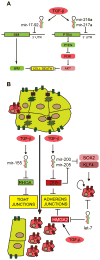EMT, cancer stem cells and drug resistance: an emerging axis of evil in the war on cancer
- PMID: 20531305
- PMCID: PMC3176718
- DOI: 10.1038/onc.2010.215
EMT, cancer stem cells and drug resistance: an emerging axis of evil in the war on cancer
Abstract
Tumors are cellularly and molecularly heterogeneous, with subsets of undifferentiated cancer cells exhibiting stem cell-like features (CSCs). Epithelial to mesenchymal transitions (EMT) are transdifferentiation programs that are required for tissue morphogenesis during embryonic development. The EMT process can be regulated by a diverse array of cytokines and growth factors, such as transforming growth factor (TGF)-beta, whose activities are dysregulated during malignant tumor progression. Thus, EMT induction in cancer cells results in the acquisition of invasive and metastatic properties. Recent reports indicate that the emergence of CSCs occurs in part as a result of EMT, for example, through cues from tumor stromal components. Recent evidence now indicates that EMT of tumor cells not only causes increased metastasis, but also contributes to drug resistance. In this review, we will provide potential mechanistic explanations for the association between EMT induction and the emergence of CSCs. We will also highlight recent studies implicating the function of TGF-beta-regulated noncoding RNAs in driving EMT and promoting CSC self-renewal. Finally we will discuss how EMT and CSCs may contribute to drug resistance, as well as therapeutic strategies to overcome this clinically.
Figures




References
-
- Baulcombe DC. Short silencing RNA: the dark matter of genetics? Cold Spring Harb Symp Quant Biol. 2006;71:13–20. - PubMed
Publication types
MeSH terms
Grants and funding
LinkOut - more resources
Full Text Sources
Other Literature Sources

